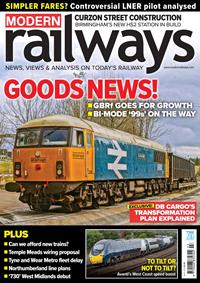|
|
The Clapham signalbox affair: SR communications and the public: How is the NER doing it?
Western's record run to Plymouth
Letters
The new image emerges on the LMR
BR's Class AL6 a.c. electric locomotives
Standard cheap fare structure on the SR
Eastern Region launches a bargain travel campaign
BR deficit cut by £13m in 1964
79 m.p.h. Rugby-Crewe with electric traction
London-Newcastle in 3hr 57min
Southern timetable in three volumes
The Midland Line's new diesel power control: Part 2
Piggyback by Kangaroo on the SNCF
The Clapham signalbox collapse
Air-sprung bogies on British Railways
A preview of LT's Victoria Line trains
London Transport in 1964
The evolution of BR track and maintenance methods: Part 1
Self-propelled tracklayer for the NER
New ER tracklaying method cuts costs and possessions
Train running and traction performance
Today and tomorrow
Accident report
The Irish scene
Beyond the Channel
New books
Traffic report
IT was fortunate that the Clapham Junction "A" signalbox subsidence stopped short of a catastrophic collapse on a passing train—or trains—otherwise some of the evidence given at the subsequent MoT enquiry must have aroused a good deal more public concern than it has. Pending appearance of the Inspecting Officer's report, there is bound to be anxious speculation whether the pro forma reports completed by a steelwork examiner during his biennial or triennial examinations are thoroughly scrutinised: and whether, with pressure for economy in expenditure on way and works, and the serious shortage of civil engineering staff in areas like London, these documents may not tend to be regarded as r routine data on which to base the next scheduled overhaul, unless the examiner puts in a supplementary special report on anything that disquiets him. Another surprising aspect of the case is that a structure of such operational importance seems to be paid only the standard degree of attention. On the evidence given at the enquiry, despite the finding of rust by an examiner in early 1961, and his emphasis of it in his report, the usual three years and more elapsed before the next inspection. One might have thought that more frequent and thorough attention would be paid to the integrity of signalling and civil engineering structures in the vital area immediately approaching the SR's London termini.
SR communications and the public:
Most of the criticism provoked by the Clapham affair has been directed at a familiar target, the deficiency of the SR's contacts with the public in an emergency. Thousands of passengers complained that, long after it was known Waterloo was put out of action, they were left ignorant to continue a bafflingly slow progress to the choked bottlenecks in the inner suburbs at which trains were being turned round. The SR frankly admits that in an emergency its communications system is inadequate and out-of-date by comparison with the standard of intensive electric train service it runs in normal circumstances. Why not then improve it? This, says Waterloo, is a question of priorities. Would the public prefer to see available funds spent on new rolling stock and more electrification, or on a thorough updating of the Region's communications? But surely some modest improvements are possible without heavy inroads into 'available capital ? The station manager concept is narrowing local responsibilities down to fewer people, who could more easily be made the channels of information to stations. If it would be too expensive to link each suburban area station manager with his Divisional headquarters in a teleprinter network (the ER's installation on the LTS line, one gathers, costs about £6,000 a year in rental charges) at least could each one not have a special omnibus-circuit "hot line" telephone from his headquarters



